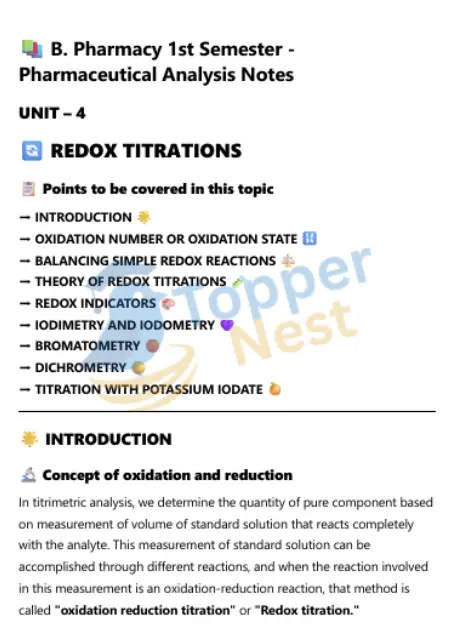Redox titrations are a critical class of volumetric analysis methods based on oxidation and reduction reactions. These reactions involve the transfer of electrons between chemical species, and are commonly used in the quantitative analysis of pharmaceuticals, particularly those containing oxidizing or reducing agents. This unit focuses on various types of redox titrations, their principles, and common pharmaceutical applications.

What is Oxidation and Reduction?
Oxidation and Reduction are fundamental chemical processes that always occur together in what are known as redox reactions (a portmanteau of reduction and oxidation). They transfer the electrons between chemical species.
Oxidation
In chemistry, oxidation is fundamentally defined as the loss of electrons by a chemical species (an atom, ion, or molecule) during a chemical reaction. This loss of electrons results in an increase in the oxidation number of the atom that is oxidized.
Key Aspects of Oxidation:
- Loss of Electrons: When a species undergoes oxidation, electrons are removed from it.
- Increase in Oxidation State: Oxidation state (or oxidation number) is a hypothetical charge that an atom would have if all bonds were ionic. When an atom loses electrons, its positive charge (or less negative charge) increases, hence its oxidation state goes up.
- Historical Definitions (and still relevant contexts):
- Gain of Oxygen: The original definition, derived from reactions with oxygen (e.g., rusting, combustion).
- Loss of Hydrogen: Particularly relevant in organic chemistry.
Reduction
Reduction is fundamentally defined as the gain of electrons by a chemical species (an atom, ion, or molecule) during a chemical reaction. This gain of electrons results in a decrease in the oxidation state (or oxidation number) of the atom that is reduced.
Key Aspects of Reduction:
- Gain of Electrons: When a species undergoes reduction, electrons are added to it.
- Decrease in Oxidation State: When an atom gains electrons, its positive charge decreases, or its negative charge increases, hence its oxidation state goes down.
- Historical Definitions (and still relevant contexts):
- Loss of Oxygen: The original definition, often seen in reactions where oxygen is removed.
- Gain of Hydrogen: Particularly relevant in organic chemistry.
Redox Titrations
Redox Titrations, short for reduction-oxidation titrations, are a powerful and widely used quantitative analytical technique in chemistry, particularly in pharmaceutical analysis. They are based on the principle of electron transfer between the reactants.
Principle of Redox Titrations:
In a redox titration, a known concentration of an oxidizing agent (the titrant) is reacted with an unknown concentration of a reducing agent (the analyte), or vice versa. The reaction proceeds until the equivalence point is reached, where the number of electrons lost by the reducing agent precisely equals the number of electrons gained by the oxidizing agent.
Key Characteristics:
- Electron Transfer: When Unlike acid-base titrations (proton transfer) or complexometric titrations (complex formation), redox titrations involve the direct transfer of electrons.
- Oxidizing Agent (Oxidant): The substance that gains electrons and is reduced in the reaction.
- Reducing Agent (Reductant): The substance that loses electrons and is oxidized in the reaction.
- Endpoint Detection: The equivalence point is typically detected visually using a redox indicator that changes color at a specific oxidation-reduction potential, or instrumentally using a potentiometer. Some titrants (like potassium permanganate) are self-indicators.
Frequently Asked Questions (FAQs)
1. What is the difference between iodimetry and iodometry?
- Iodimetry is a direct titration using iodine solution.
- Iodometry is an indirect method where iodine is liberated during the reaction and titrated with thiosulfate.
2. Why is potassium dichromate preferred over potassium permanganate in some titrations?
Potassium dichromate is more stable, does not self-decompose, and offers sharper endpoints, especially in back titration procedures.
3. What indicators are used in redox titrations?
Depending on the titration, indicators like starch (for iodine), ferroin, diphenylamine, and N-phenylanthranilic acid are used.
4. How does bromatometry differ from cerimetry?
- Bromatometry uses bromate to generate bromine in situ for oxidation.
- Cerimetry directly uses Ce⁴⁺ as a strong oxidizing agent.
5. Which redox titration is suitable for estimating hydrogen peroxide?
Iodometry and cerimetry are both commonly used for the quantitative analysis of H₂O₂ in pharmaceutical and lab settings.
